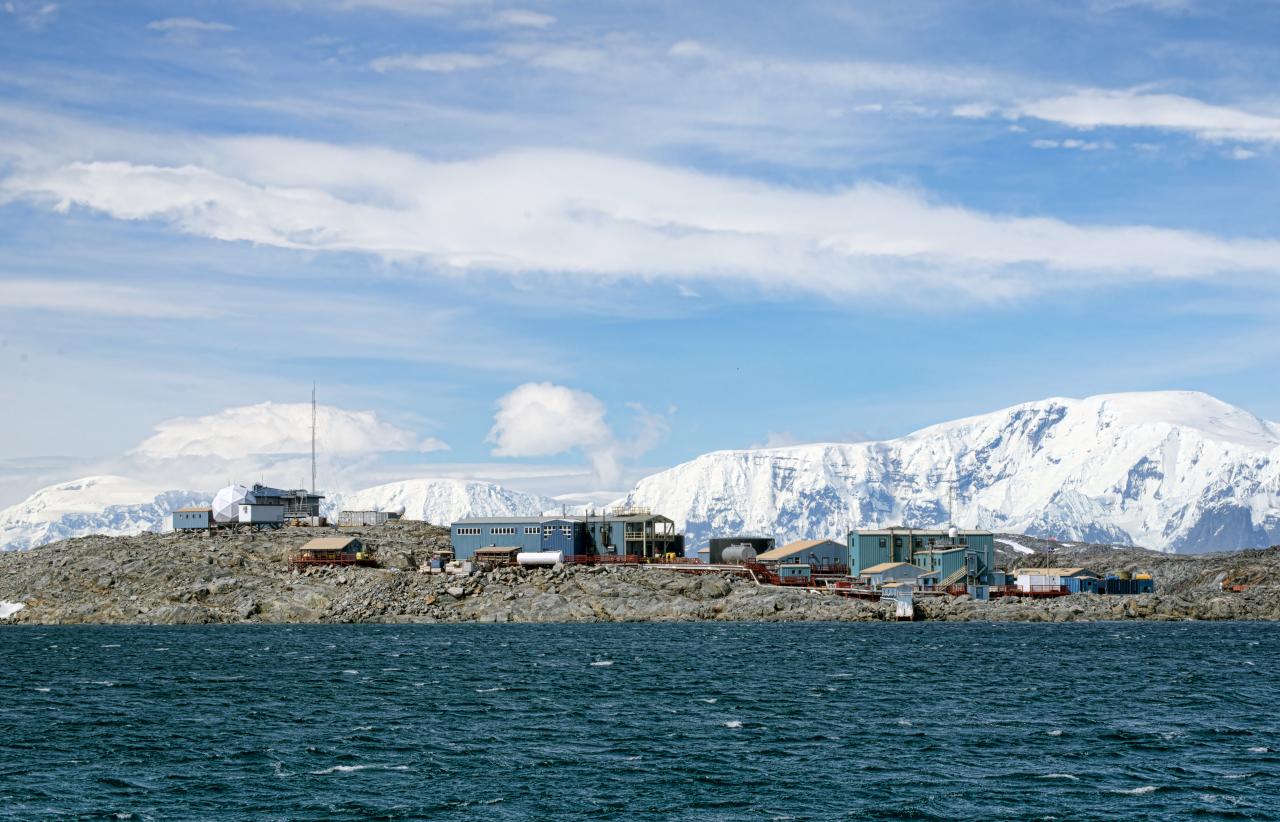PALMER STATION
(click for Palmer station cover - clicca qui per le buste di Palmer Station)
from www.usap.gov/videoclipsandmaps/palwebcam.cfm (sotto la traduzione in italiano)
Located on Anvers Island near the Antarctic Peninsula, Palmer Station (64° 46’S, 64° 03’W) is named for Nathaniel B. Palmer, who in 1820 on a sealing expedition in his 47-foot (14-meter) ship the Hero became the first American to record sighting Antarctica. The original station was built in 1965. In 1967, the U.S. Navy began construction of the current larger and more permanent station approximately a mile east of the original site. The first building at the new station, the biology laboratory, opened its doors to science in 1970. Today, two main buildings and several smaller structures make up Palmer Station and provide housing and research facilities for scientists and support personnel. Of the three U.S. Antarctic stations, Palmer is the only one that is accessed routinely during the winter.
With ice cliffs rising above Arthur Harbor and the station, the Marr Ice Piedmont covers Anvers Island. The highest mountains on the island are Mt. Francais (9,055 feet/2,760 meters) and Mt. Agamemnon (8,438 feet/2,572 meters).
Average temperatures are 36° F (2° C) in austral summer and 14° F (-10° C) in austral winter. The station frequently experiences high winds, sometimes reaching 70 knots or more. Average annual precipitation is 13 feet (4 meters) of snow and 30 in (76 cm) of rain. Palmer Station lies outside the Antarctic Circle, so in the middle of austral winter there are five hours of light during each day. Conversely, the austral summer brings long days of 19 hours of light and 5 of twilight. These changes in light influence seasonal cycles of temperature, weather, sea ice formation, and the organisms that live in this area.
The station supports science year-round and accommodates about 20 people in the winter and up to 44 in the austral summer. There are dormitory bedrooms, communal bathrooms, and a cafeteria-style kitchen. Everyone helps clean, and many participate in weekly science lectures and social events.

"Palmer Station Antarctica seaside" by *christopher*
(Flickr: Antarctica 2013: Journey to the Crystal Desert. Licensed under CC BY 2.0 via Wikimedia Commons -https://commons.wikimedia.org/wiki/File:Palmer_Station_Antarctica_seaside.jpg#/media/File:Palmer_Station_Antarctica_seaside.jpg)
Libera traduzione di Modina Davide.
Localizzata sull'isola di Anvers, vicino alla penisola Antartica, Palmer Station prende il nome da Nathaniel B. Palmer che nel 1820, durante una spedizione a bordo della nave The Hero, divenne il primo americano ad avvistare il continente antartico
La stazione originale venne costruita nel 1965. Nel 1967 la marina statunitense iniziò la costruzione di una nuova base (quella attualmentein uso) ad un miglio di distanza da quella originale. Il primo edificio, un laboratorio di biologia, aprì le porte alla scienza nel 1970. Attualmente Palmer Station è costituita da due grandi edificio che, assieme ad altre piccole costruzione, funzionano da centro di ricerca e danno ospitalità agli scienziati e al personale. Delle tre stazioni antartiche americane Palmer station è l'unica che può essere raggiunta regolarmente anche d'inverno.
Il Marr Ice Piedmont copre l'isola di Anvers con le imponenti scogliere di ghiaccio che si possono scorgere dietro Arthur Harbor e la stazione. I monti più alti dell'isola sono il Monte Francais (2760 metri) e il Monte Agamemnon (2572 metri)
Le temperature medie variano dai 2˚C dell'estate australe ai -10˚C dell'inverno. La stazione è spesso soggetta a forti venti che possono raggiungere i 70 nodi. Annulmente cadono in media 4 metri di neve e 76 cm di pioggia. Palmer Station si trova fuori dal circolo polare antartico per cui nel pieno dell'inverno australe abbiamo 5 ore di luce durante la giornata mentre, al contrario, nel mezzo delll'estate la luce dura 19 ore a fronte di sole 5 ore di buio.
Il cambiamento della durata del giorno influenza il ciclo stagionale delle temperature, del tempo, delle formazioni di ghiaccio e degli organismi che vivono in quest'area.
La stazione, aperta tutto l'anno, ospita circa 20 persone in inverno che salgono a 44 in estate. Sono presenti un dormitorio, delle camere da letto, dei bagni pubblici e una caffetteria/tavola calda. Tutti aiutano a pulire e molti partecipano alle letture scientifiche settimanali oltre che ad altri eventi sociali che vengono organizzati

Commenti - Opinions
Nessun commento trovato.
